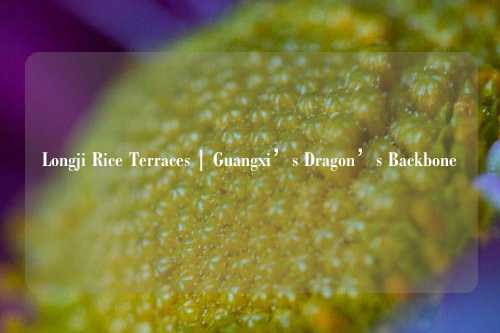Longji Rice Terraces | Guangxi’s Dragon’s Backbone
Nestled in the heart of Guangxi Zhuang Autonomous Region, the Longji Rice Terraces stand as a testament to human ingenuity and a harmonious coexistence with nature. These terraces, often referred to as the "Dragon’s Backbone," are a series of stair-step fields that cascade down the hills, creating a breathtaking mosaic across the landscape. Designed by the Dong族 people, these terraces are not only a marvel of agri engineering but also a living museum of Chinese heritage.
The history of the Longji Rice Terraces dates back over 600 years, with the first construction believed to have started in the Yuan Dynasty. Over the centuries, the terraces have undergone numerous expansions and enhancements, becoming a symbol of resilience and adaptability. The techniques employed to build these terraces remain largely unchanged, showcasing the wisdom of ancient farmers who understood the importance of preserving their environment while ensuring food security for future generations.

Visitors to Longji are greeted by a landscape that seems to come straight out of a postcard. During the rainy season, the terraces are lush and green, while in the dry season, the golden hues of ripening rice create a striking contrast against the deep greens of surrounding bamboo forests. The terraces are a labyrinth of narrow paths, each leading to a new perspective, offering endless opportunities for exploration and photography. The sound of flowing water from the canals that feed the terraces adds a soothing background symphony to the serene environment, making it a true paradise for nature lovers.
The interplay of light and shadow across the terraces, especially at sunrise and sunset, transforms the landscape into a dynamic painting. These moments are highly sought after by photographers, who gather to capture the fleeting beauty. The terraces are also home to an array of wildlife, including migratory birds that find refuge in the rice paddies, adding another layer of life to this already vibrant ecosystem.
Beyond their natural beauty, the Longji Rice Terraces hold a deep significance. They are more than just a farming site; they are a representation of the enduring spirit of the people who have lived here for generations. The terraces are a place of worship, tradition, and daily life, where the farmers continue to practice age-old customs, passing them down through generations.
The local festivals and rituals offer a glimpse into the rich tapestry of the region. For instance, during the spring planting season, villagers perform dances and sing songs that have been passed down orally for centuries. These events are not just celebrations of the agri cycle but also a means of strengthening communal bonds and preserving identity.
The cuisine of the region is another aspect that reflects the connection between the people and the land. The diet is heavily reliant on the staples grown in the terraces, such as rice, fish, and vegetables. Dishes like "fish porridge" and "stinky tofu" are local delicacies that visitors can enjoy while experiencing the warm hospitality of the villagers. Walking through the villages, one can observe the architecture, which blends functionality with aesthetic appeal, offering a glimpse into the daily lives of the inhabitants.
In recent years, the Longji Rice Terraces have become a popular eco-tourism destination, attracting visitors from around the world. The local government and communities have made efforts to promote tourism, ensuring that the preservation of the terraces aligns with the region’s development. Guided tours, homestays, and workshops provide visitors with immersive experiences, allowing them to appreciate the beauty and richness of Longji in a responsible manner.
The Longji Rice Terraces are more than just a destination; they are a living legacy, a place where tradition and nature come together in perfect harmony. For those who visit, it is an opportunity to step away from the hustle and bustle of modern life and reconnect with the essence of the Earth. Here, amidst the terraced fields that resemble a dragon’s backbone, one can find both peace and inspiration, a reminder of the beauty and resilience of the human spirit.
















